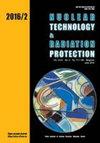以微量锕系元素为燃料,设计用于乏燃料浓缩和裂变燃料生产的中子分析
IF 0.9
4区 工程技术
Q3 NUCLEAR SCIENCE & TECHNOLOGY
引用次数: 1
摘要
本文采用设计A和设计b两种不同的氦冷却加速器驱动系统,对从加拿大氘铀和压水堆乏燃料中取出的铀和从钍中增殖的裂变燃料进行了浓缩分析。一开始,从反应堆乏燃料中取出的铀燃料中的235U百分比分别为0.17%和0.91%。两个系统核心都用从PWR-MOX乏燃料中提取的两种不同的微量锕系元素成分作为燃料。A型设计在燃料堆芯周围有一个嬗变区(浓缩区),含有钍或乏铀燃料,而B型设计在第一个嬗变区周围有第二个嬗变区(裂变燃料增殖区),只含有钍燃料。简而言之,共分析了加速器驱动系统设计、微量锕系元素成分和乏铀含钍燃料组合形成的10个案例,其中设计a中包含一个嬗变区有6个,设计B中包含两个嬗变区有4个。采用铅铋共晶合金作为靶材料,铅铋共晶合金是一种由45%的铅和55%的铋组成的液态重金属。假设目标被1.2383轰炸?每秒1017个质子,每个质子的能量是1000兆电子伏。这意味着质子束的功率为20兆瓦。利用MCNPX 2.7和CINDER 90核程序进行了三维和时变中子分析。两种加速器驱动的系统设计都运行到keff值上升到0.985,以确定在所有情况下的最长运行时间,即有效燃烧时间。根据设计、微量锕系元素组成和燃料类型(废UO2和废ThO2)的不同,循环结束时得到的结果表明,有效燃烧时间在300 ~ 2050天之间,燃料富集度可达2.49 ~ 4.23%,增益值可达10.8 ~ 25.1。本文章由计算机程序翻译,如有差异,请以英文原文为准。
Neutronic analysis of an ads fuelled with minor actinide and designed for spent fuel enrichment and fissile fuel production
This paper presents analyses of enrichments of uranium taken out from Canada Deuterium Uranium and pressurized water reactors spent fuels and fissile fuel breeding from thorium in two different helium cooled-accelerator driven system designs, DESIGN A and DESIGN B. In the beginning, the 235U percentages in the uranium fuels taken out from the reactors spent fuels are 0.17% and 0.91%, respectively. Both system cores are fuelled with two different minor actinides compositions extracted from PWR-MOX spent fuels. The DESIGN A has one transmutation zone (enrichment zone) surrounding the fuel core and containing thorium or spent uranium fuels, while DESIGN B has a second transmutation zone (fissile fuel breeding zone) surrounding the first transmutation zone and containing only thorium fuel. In brief, a total of ten cases formed by the combinations of accelerator driven system designs, minor actinides components, and spent uranium with thorium fuels are analysed, which are six in DESIGN A containing one transmutation zone and four in DESIGN B containing two transmutation zones. Lead-bismuth eutectic alloy, a liquid heavy metal, consisting of 45% lead and 55 % bismuth is used as target material in the investigated accelerator driven system. It is assumed that the target is bombarded with 1.2383?1017 protons per second and that the energy of each proton is 1000 MeV. This means a proton beam power of 20 MW. The 3-D and time-dependent neutronic analyses are conducted by using the MCNPX 2.7 and CINDER 90 nuclear code. Both accelerator driven system designs are operated until the values of keff rise to 0.985 to determine the longest operation times that are the effective burn times in all cases. Depending on the design, minor actinide composition, and fuel type (spent UO2 and ThO2), the results obtained at the end of cycle exhibit the effective burn times vary from 300 days to 2050 days, the fuel enrichments can reach up to 2.49-4.23% and the values of gain reach up to 10.8-25.1.
求助全文
通过发布文献求助,成功后即可免费获取论文全文。
去求助
来源期刊

Nuclear Technology & Radiation Protection
NUCLEAR SCIENCE & TECHNOLOGY-
CiteScore
2.00
自引率
41.70%
发文量
10
审稿时长
6-12 weeks
期刊介绍:
Nuclear Technology & Radiation Protection is an international scientific journal covering the wide range of disciplines involved in nuclear science and technology as well as in the field of radiation protection. The journal is open for scientific papers, short papers, review articles, and technical papers dealing with nuclear power, research reactors, accelerators, nuclear materials, waste management, radiation measurements, and environmental problems. However, basic reactor physics and design, particle and radiation transport theory, and development of numerical methods and codes will also be important aspects of the editorial policy.
 求助内容:
求助内容: 应助结果提醒方式:
应助结果提醒方式:


